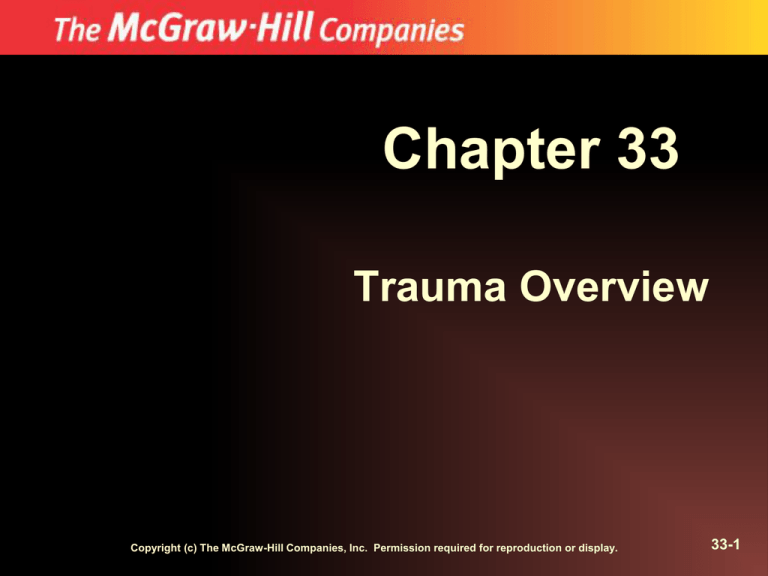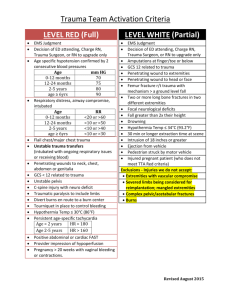Chapter 33 Trauma Overview 33-1
advertisement

Chapter 33 Trauma Overview Copyright (c) The McGraw-Hill Companies, Inc. Permission required for reproduction or display. 33-1 Objectives 33-2 Reconsidering the Mechanism of Injury • Perform a scene size-up and primary survey • Reconsider the mechanism of injury (MOI) – MOI is the way in which an injury occurs, as well as the forces involved in producing the injury – Reevaluating the MOI is necessary to rule out the possibility of a more significant MOI than initially suspected or identified during the scene size-up. – Index of suspicion 33-3 Factors to Consider In a Motor Vehicle Crash • • • • • • • • Rate of speed Seatbelt use Impact site Amount of intrusion Airbag deployment Vehicle size Condition of steering wheel Condition of windshield 33-4 Significant Mechanism of Injury • • • • • • • Golden hour Limit scene time to 10 minutes Perform a primary survey Follow with a rapid trauma assessment Move quickly and efficiently Consider the need for ALS personnel Consider immediate transport 33-5 Significant Mechanisms of Injury • Penetrating injury to the head, neck, or torso • Penetrating injury to the extremities above the elbow or knee • Flail chest • Combination trauma with burns • Two or more proximal long-bone fractures • Pelvic fractures • Open or depressed skull fracture • Paralysis • Amputation above the wrist or ankle • Major burns 33-6 MOI – Not Significant • Perform a primary survey • Begin the secondary survey with an assessment of the injured body part (focused physical exam) – Examine other areas of the body as needed 33-7 Significant Mechanism of Injury • Perform a rapid trauma assessment when: – A significant mechanism of injury exists – Additional injuries are suspected – A critical injury is found during the focused physical examination – A previously stable patient with no significant mechanism of injury becomes unstable during the focused physical examination – After providing any emergency intervention 33-8 Significant Mechanism of Injury • Spinal precautions as soon as practical based on MOI • Primary survey – Airway – Breathing – Circulation – Disability – Expose 33-9 Significant Mechanism of Injury • Rapid trauma assessment – Reassess mental status – Assess • • • • • • • • Head Neck Chest Abdomen Pelvis Lower extremities Upper extremities Back – Compare one side of the body to the other 33-10 Revised Trauma Score (RTS) • Scoring system used to predict the likelihood of serious injury or death following trauma • Calculated from a combination of results from three categories A. Respiratory rate B. Systolic blood pressure C. Glasgow Coma Scale 33-11 Transport of the Priority Trauma Patient • Consider the following: – Distance to the nearest Trauma Center – Availability of ground versus air ambulances – Time of day (traffic conditions) – Weather 33-12 Trauma Patient Considerations • If no significant mechanism of injury – Perform a focused trauma assessment • Assess the injured area for DCAP-BTLS • Assess vital signs • Obtain a SAMPLE history – Provide emergency care based on the type and severity of the injury 33-13 Key Point • If the patient appeared stable at the end of the primary survey, but becomes unstable during the secondary survey, expedite patient transport to the closest appropriate medical facility. 33-14 Questions? 33-15


